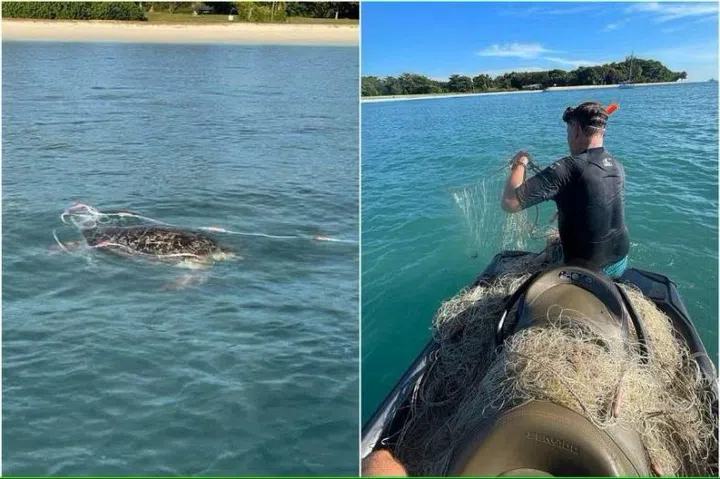Green turtles die after being trapped in fishing net, two of four marine animals trapped on Nov 18
Boat captain Muhammad Nazri Idris was on a yacht off Lazarus Island at around 5pm on Nov 18 when he discovered a 100m-long fishing net nearby.
"I knew I needed to remove the net as I didn't want my propellers or any other boat to get entangled in such a situation. Also, it was very dangerous for swimmers, and it could also harm the marine life," he said.
As he began to reel the net in, his worst fears were realised - a green turtle was entangled in it.
Mr Nazri, 30, who was with 24 passengers on board the yacht in the waters off Eagle Bay, told The Straits Times on Nov 19 that the turtle was "alive but in pain". He tried to free it by cutting the net with a knife.
As he continued to pull the net in, he discovered another green turtle entangled in the net.
"We left the area immediately with the net and rushed back to One°15 Marina while waiting for Acres to arrive," said Mr Nazri, a yacht captain at yacht charter company Infinity Sails, referring to the Animal Concerns Research and Education Society (Acres), which rescues wildlife in Singapore.
He added that one of the turtles died while they were waiting for help to arrive, although they did what they could to try and keep the turtles alive, such as covering the animals with towels that had been soaked in seawater.
"It took me more than an hour to remove the net," he said.
"I have been working out at sea for seven years, and this was my first time (seeing) such cruel incidents happening to the marine animals, especially since Lazarus and the nearby islands are a sacred place for sea turtles."
Mr Kalai Vanan Balakrishnan, co-chief executive of Acres, told ST that when its officers rushed down, the other turtle had also died.
Describing it as a "tragic incident for the endangered species", he said: "The two turtles must have been entangled for a long time and died from stress and drowning besides other factors."
In a Facebook post on the night of Nov 18, conservation non-profit organisation Marine Stewards thanked the crew of Infinity Sails for working hard in the rain to remove the net.
A video posted by the group shows two men working to cut the net that was entangled around the turtle's body and limbs.
The group said in a follow-up post that nets are ecological and safety hazards, adding that they should not be allowed in "ecologically sensitive" areas, as well as places with boat traffic.
The incident involving the dead turtles took place just hours after another turtle and stingray were freed from a net in the same area.
On the morning of Nov 18, two men spotted a hawksbill turtle and a blue-spotted ribbontail stingray caught in a 100m-long fishing net off Lazarus Island. They managed to free both animals and pull the net to shore to prevent other creatures from being trapped.

Hawksbill turtles and green turtles are both critically endangered locally.
According to the National Parks Board (NParks) website, hawksbill turtles prefer shallow coral reefs over deep waters, and feed mainly on sponges and crustaceans.
Mr Ryan Lee, group director of NParks' National Biodiversity Centre, told ST in March that green turtles can be found near coastlines worldwide, especially in areas with seagrass beds.

Dr Zeehan Jaafar, a marine biologist and senior lecturer at the National University of Singapore, told ST that the huge nets, known as gill nets, have floats at the top and weights below to hold them upright so they can catch everything in their path. A turtle trapped below the water's surface in these nets can drown in minutes, depending on its "energy budgets" and stress levels, she added.
A spokeswoman for Marine Stewards said anyone who comes across trapped live animals in the sea can try to free the animals safely, if possible. Otherwise, they should call NParks or the Maritime and Port Authority of Singapore (MPA) if the nets are a hazard.
The gill net fishing method is legal in some countries but illegal in others.
Net fishing in the 12 coastal parks and areas managed by NParks is forbidden because of the damage the method has on marine life.
But the Fisheries Act, which regulates the fishing industry here, does not ban the use of gill nets outside of these areas. Instead, it can be illegal to damage the fishing implement.
Acres' Mr Kalai called for more to be done towards the banning of gill nets in Singapore's waters.
"Gill nets are highly destructive to our ecosystem. They are often used indiscriminately and many animals suffer and die a slow painful death," he said.
The waters off Lazarus Island are managed by MPA.
ST has contacted MPA for more information.
According to the SG Marine Guide, Lazarus Island Beach is a popular boating destination for boat charterers, jet skis, kayakers and private boats. It is also a "great place for a beach fire, barbecue, fishing and camping overnight".
- Additional reporting by Carmen Sin